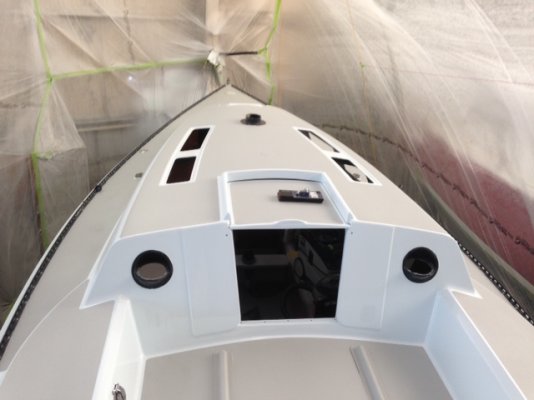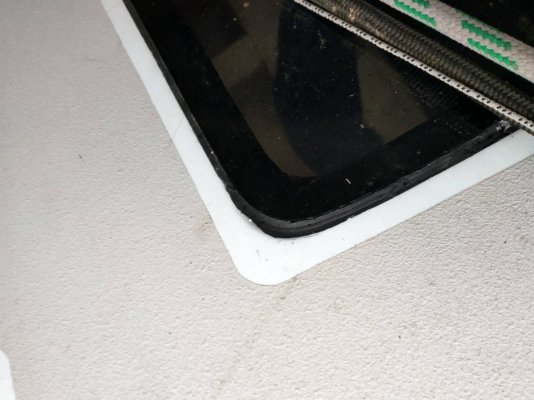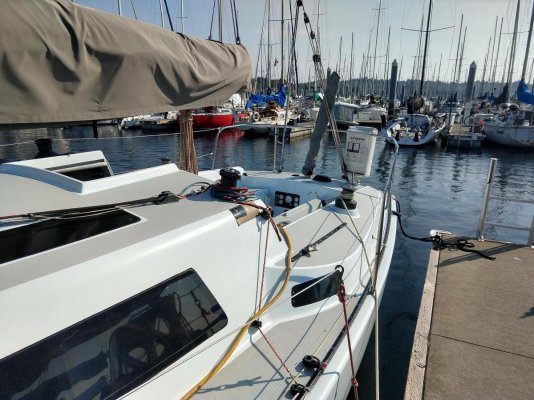NonTrawler
Newbie
- Joined
- Feb 16, 2021
- Messages
- 3
- Vessel Name
- Muffin
- Vessel Make
- Santa Cruz 33 (sail)
Hi all,
This is my first post to the forum, so hopefully I'm doing it all right.
I'm hoping some you further along on the learning curve might advise me on a dripping matter. The matter at hand are leaking lexan skylights that are recessed in the cabin top of our (sail)boat. Originally fasteners were used every ~5-6 inches but the previous owner didn't like holes in the deck (which I appreciate) and went with an adhesive only approach to set and seal the skylight to the fiberglass and gelcoat. He used Sikaflex 295 for the job. According to him it lasts a year or so, but I'm thinking it's a lot less that that because it was redone a 6-7 months ago and it's leaking now. I can only assume it's a bonding issue or an elongation problem as there is some (appropriate, not excessive or spongy) flex in the cabin roof and in the lexan. The windows (ports?) are installed the same, but they don't seem to leak, probably because water isn't sitting on them like the skylight.
Sikaflex 295 seems to be spec'ed for organic glass (not sure what that is) which I pretty sure doesn't includes lexan . The rated elongation is 500%, which I think would be enough in this case. The Sika 295 is rated for UV, which is good because the joint is fully exposed to the outside.
. The rated elongation is 500%, which I think would be enough in this case. The Sika 295 is rated for UV, which is good because the joint is fully exposed to the outside.
I read a lot about butyl tape here and elsewhere, as well as Bed-It, the butyl-like option, and am pretty convinced that it would seal but it's not an adhesive so the skylight may not stay in place.
Anyway, this is where you all come in...what would you suggest I use once I remove the 295?
Is there butyl-tape that's adhesive enough?
Is there a butyl-based adhesive?
I'm guessing that 3M 5200 would work but I think it's more permanent than I would want. 4200 is not supposed to be used with lexan.
Is this an appropriate place for dreaded silicon?
I would like it to skin over so that people sitting on the cabin top would not be attacked by the sealant. It should be UV resistant as well.Oh, and not leak.
I've attempted to add three photos: 1 of the deck without the skylight, 2 with the skylight as currently installed.
Thanks in advance.
Mark
This is my first post to the forum, so hopefully I'm doing it all right.
I'm hoping some you further along on the learning curve might advise me on a dripping matter. The matter at hand are leaking lexan skylights that are recessed in the cabin top of our (sail)boat. Originally fasteners were used every ~5-6 inches but the previous owner didn't like holes in the deck (which I appreciate) and went with an adhesive only approach to set and seal the skylight to the fiberglass and gelcoat. He used Sikaflex 295 for the job. According to him it lasts a year or so, but I'm thinking it's a lot less that that because it was redone a 6-7 months ago and it's leaking now. I can only assume it's a bonding issue or an elongation problem as there is some (appropriate, not excessive or spongy) flex in the cabin roof and in the lexan. The windows (ports?) are installed the same, but they don't seem to leak, probably because water isn't sitting on them like the skylight.
Sikaflex 295 seems to be spec'ed for organic glass (not sure what that is) which I pretty sure doesn't includes lexan
I read a lot about butyl tape here and elsewhere, as well as Bed-It, the butyl-like option, and am pretty convinced that it would seal but it's not an adhesive so the skylight may not stay in place.
Anyway, this is where you all come in...what would you suggest I use once I remove the 295?
Is there butyl-tape that's adhesive enough?
Is there a butyl-based adhesive?
I'm guessing that 3M 5200 would work but I think it's more permanent than I would want. 4200 is not supposed to be used with lexan.
Is this an appropriate place for dreaded silicon?
I would like it to skin over so that people sitting on the cabin top would not be attacked by the sealant. It should be UV resistant as well.Oh, and not leak.
I've attempted to add three photos: 1 of the deck without the skylight, 2 with the skylight as currently installed.
Thanks in advance.
Mark



